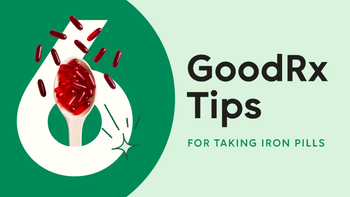
What to Know About Iron Infusions for Iron Deficiency Anemia
Key takeaways:
Iron infusions are an effective way to treat iron deficiency anemia (IDA) when oral iron supplements aren’t working or can’t be used.
Iron infusions are given directly into a vein. Infusion times range from less than 20 minutes to up to 4 hours.
Iron infusion side effects vary depending on which form is being used. Side effects like nausea and low blood pressure are common with most iron infusions.

Anemia is the most common blood disorder in the U.S., affecting about 3 million Americans. This condition happens when you don’t have enough red blood cells — the cells responsible for carrying oxygen to the rest of your body. Anemia can cause you to have symptoms such as tiredness, trouble focusing, or headaches.
The most common type of anemia is iron-deficiency anemia (IDA). This happens when you don’t have enough iron in your body. Iron is a key mineral needed to create red blood cells. Iron supplements are used to treat IDA.
Many people with IDA can take over-the-counter (OTC) iron supplements by mouth. But some people need to receive iron slowly into a vein in order to treat the condition. This process is called an iron infusion. There are several types of iron infusions that can be used depending on your personal situation.
Here, we’ll discuss the basics of iron infusions — how they work and what to expect if you need to receive them.
What is an iron infusion?
An iron infusion is one way to receive extra iron when your natural stores of iron are low. There are a handful of different iron infusions available for IDA. As listed below, the one that’s used for you can depend on the cause of your IDA, as well as your age.
FDA-approved iron infusions include:
Feraheme (ferumoxytol). This iron infusion has two FDA-approved uses. It can be used for IDA in adults ages 18 years and older who can’t take oral iron supplements or if oral iron didn’t work. It can also be used for IDA in adults with chronic kidney disease (CKD).
Ferrlecit (sodium ferric gluconate). This can be used for IDA in people ages 6 years and older who have CKD and are also receiving Procrit (epoetin alfa) treatment and hemodialysis.
Injectafer (ferric carboxymaltose). This has two approved uses. It can be used for IDA in people ages 1 year and older who can’t take oral iron supplements or if oral iron didn’t work. It can also be used for adults ages 18 years and older with CKD who don’t need hemodialysis.
Monoferric (ferric derisomaltose). This also has two approved uses. It can be used for IDA in adults ages 18 years and older who can’t take oral iron supplements or if oral iron didn’t work. It can also be used for adults with CKD who don’t need hemodialysis.
Triferic AVNU (ferric pyrophosphate citrate). This is used for adults with CKD who receive hemodialysis. It’s used to prevent IDA.
Venofer (iron sucrose). This can be used for IDA in people ages 2 years and older who have CKD.
Another form of injectable iron is a medication called INFeD (iron dextran). But this medication isn’t available as an infusion. While INFeD would still be given through an intravenous (IV) needle, it wouldn’t take as long to receive as an iron infusion. The remainder of this article will focus on forms of iron that can be infused.
How do iron infusions work for iron deficiency anemia?
The goal of any iron supplement is to replace the iron that’s missing from the body. Once iron supplies are back to a more normal level, more hemoglobin should be made. Hemoglobin is a protein that helps create new red blood cells. Ultimately, this allows more oxygen to reach cells and relieves IDA symptoms, like fatigue.
Iron infusions allow iron levels in the body to go up much faster than oral iron supplements. Iron infusions also aren’t as tough on the stomach as oral iron. That’s why iron infusions are useful for people who have very low iron levels or can’t tolerate oral iron.
How is an iron infusion given when treating iron deficiency anemia?
The dose for iron infusions varies depending on which product you’re receiving. Below, we’ve provided a handy table that lists the doses for each iron infusion.
| Medication name | Dose given | How often is it repeated? |
|---|---|---|
| Feraheme | 510 mg infused over at least 15 minutes | Two total doses are given. The second dose is given 3 to 8 days after the first dose. |
| Ferrlecit | Adults: 125 mg infused over 1 hour or pushed (injected faster) over a 10-minute period Children: 1.5 mg/kg body weight (125 mg maximum) infused over 1 hour |
Repeated with every dialysis session |
| Injectafer | Two-dose option for people weighing 110 pounds or more: 750 mg infused over at least 15 minutes or pushed over a 7- to 8-minute period Single-dose option for people weighing 110 pounds or more: 1,000 mg infused over at least 15 minutes or pushed over a 15-minute period Two-dose for people weighing under 110 pounds: 15 mg/kg body weight infused over at least 15 minutes or pushed over 15 minutes |
Two-dose option: There must be at least 7 days between each dose. Single-dose option: Repeat doses only needed if future blood tests show IDA. This option is less preferred, since it can cause more skin and tissue irritation. |
| Monoferric | For people weighing 110 pounds or more: 1,000 mg infused over at least 20 minutes
For people weighing under 110 pounds: 20 mg/kg body weight infused over at least 20 minutes |
Repeat doses only needed if future blood tests show IDA. |
| Triferic AVNU | 6.75 mg infused over 3 to 4 hours during a dialysis session | Repeated with every dialysis session |
| Venofer | Adults who don’t receive dialysis: 200 mg infused over 15 minutes or pushed over 2 to 5 minutes
Adults who receive hemodialysis: 100 mg infused over at least 15 minutes or pushed over 2 to 5 minutes Adults who receive peritoneal dialysis: two doses of 300 mg infused over 1.5 hours followed by a 400 mg dose infused over 2.5 hours Children: doses should be personalized by your child’s healthcare provider based on body weight |
Adults who don’t receive dialysis: Doses should be repeated 5 times within a 14-day period.
Adults who receive hemodialysis: Repeat doses only needed if future blood tests show IDA. Adults who receive peritoneal dialysis: Each of the three doses are separated by 14 days. Children: Doses should be personalized by your child’s healthcare provider. |
What are the potential side effects?
Side effects vary, depending on which iron infusion is being used. Some are more well-tolerated than others. It’s important to let the healthcare professional giving you the medication know if you experience any side effects during your infusion.
Common side effects
Ferrlecit has a number of common side effects:
Nausea, vomiting, and diarrhea
Irritation where the medication was infused
Low or high blood pressure
Cramps
Dizziness
Triferic AVNU also tends to cause more side effects:
Low blood pressure during infusion
Muscle spasms
Headache
Swelling or pain in the arms or legs
Fever
Venofer side effects tend to be slightly more common for people receiving dialysis:
Low or high blood pressure
Muscle cramps
Nausea, vomiting, and diarrhea
Headache
Cold-like symptoms
Feraheme side effects are relatively uncommon but include:
Headache
Nausea
Dizziness
Low blood pressure
Swelling in the arms or legs
Injectafer has fewer common side effects:
Nausea
High blood pressure
Irritation at the infusion site
Flushing
Most people have no side effects with Monoferric. Nausea and rash were the only two mild side effects reported in studies.
Serious side effects
One of the biggest risks with iron infusions is the possibility of serious allergic reactions. Because of this, you’ll be closely watched during and right after your infusion for signs of a reaction. It’s important to note that this is rare, happening to less than 1% of people who receive iron infusions.
Feraheme, Ferrlecit, and Venofer also carry a risk of severe low blood pressure. This could cause you to pass out or fall after your iron infusion. This side effect usually resolves on its own in the hours following your infusion. But it could cause you to accidentally hurt yourself. Let your healthcare provider know if you faint or feel dizzy after any iron infusion.
Feraheme, Ferrlecit, Triferic AVNU, and Venofer can also cause trouble breathing for some people. While considered a mild side effect, it can be scary if it happens to you. And if you have other lung conditions, like asthma, breathing problems can be more serious. Let your healthcare provider and the nurse giving you the infusion know if you notice any breathing difficulties during your iron infusion.
How effective is an iron infusion when treating iron deficiency anemia?
Multiple studies have shown that iron infusions are more effective than oral iron for IDA. In many cases, a single iron infusion can fully replace iron supplies in the body. But iron infusions don’t just raise iron levels. They also quickly relieve IDA symptoms, allowing people to feel more like themselves again sooner.
Iron infusions start to kick in within about a week. Hemoglobin levels should go up within 2 to 3 weeks. To compare, oral iron can take 3 to 6 months to treat IDA.
How to save on your iron infusion
Iron infusions aren’t medications you would fill at your local community pharmacy. These medications are typically given at an infusion center. Because of this, iron infusions would likely be covered under your medical insurance — not your prescription insurance. It’s best to discuss cost with your healthcare provider’s office.
This topic is discussed in-depth in another GoodRx Health article.
What are some alternatives to an iron infusion?
Iron infusions for IDA are used when oral iron doesn’t work or isn’t an appropriate treatment. Alternatives are limited if iron infusions aren’t working for you. In severe cases of IDA, a blood transfusion may be used to temporarily relieve symptoms. But transfusions won’t correct your IDA.
Your healthcare provider will help decide which IDA treatments are best for you. Speak with your provider if you’re concerned about your iron infusion or to discuss next steps.
The bottom line
Iron infusions are an effective way to treat IDA. They’re a good choice if oral iron supplements aren’t right for you. These IDA treatments are relatively safe, but can cause serious allergic reactions for a small number of people. Some iron infusions are better tolerated than others, so be sure to discuss your options with your healthcare provider.
Why trust our experts?


References
A-S Medication Solutions. (2021). Venofer [package insert].
Allergan, Inc. (2021). INFeD [package insert].
AMAG Pharmaceuticals, Inc. (2020). Feraheme [package insert].
American Regent, Inc. (2021). Injectafer [package insert].
American Society of Hematology. (2022). Anemia.
American Society of Hematology. (2022). Iron-deficiency anemia.
Auerbach, M., et al. (2010). Clinical use of intravenous iron: administration, efficacy, and safety. Hematology, American Society of Hematology Education Program.
Baird-Gunning, J. (2016). Correcting iron deficiency. Australian Prescriber.
Cançado, R. D., et al. (2021). Intravenous iron therapy: how far have we come? Revista brasileira de hematologia e hemoterapia.
National Institute of Diabetes and Digestive and Kidney Diseases. (2018). Peritoneal dialysis.
National Kidney Foundation. (2015). Hemodialysis.
National Library of Medicine. (2018). Iron supplements.
Nguyen, M., et al. (2021). Iron supplementation. StatPearls.
Pharmacosmos Therapeutics Inc. (2020). Monoferric [package insert].
Rockwell Medical Inc. (2020). Triferic AVNU [package insert].
Sanofi-Aventis U.S. LLC. (2021). Ferrlecit [package insert].
Wang, C., et al. (2015). Comparative risk of anaphylactic reactions associated with intravenous iron products. JAMA.

























